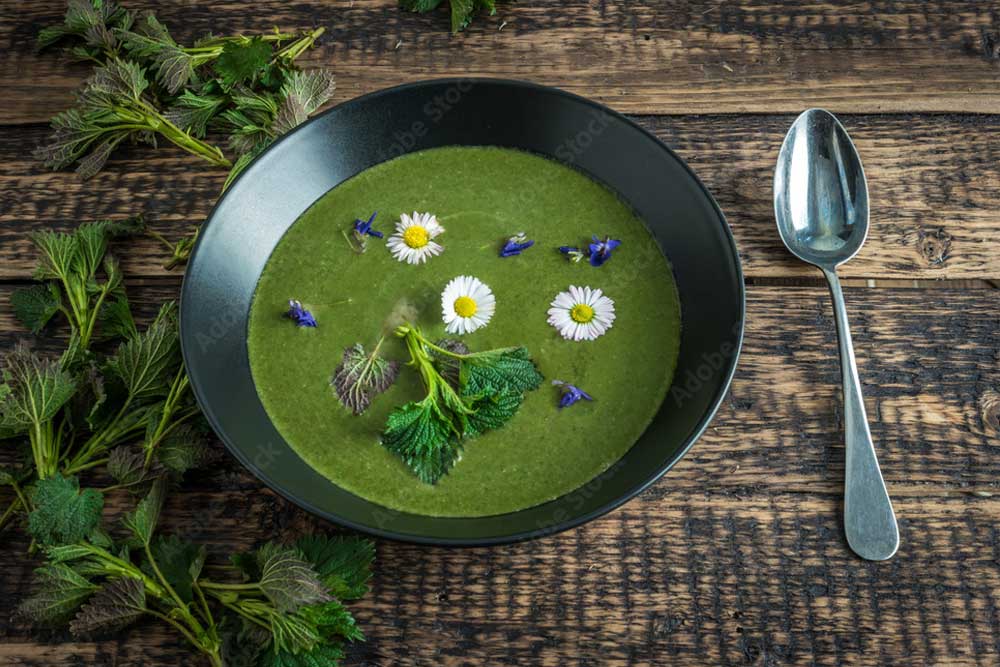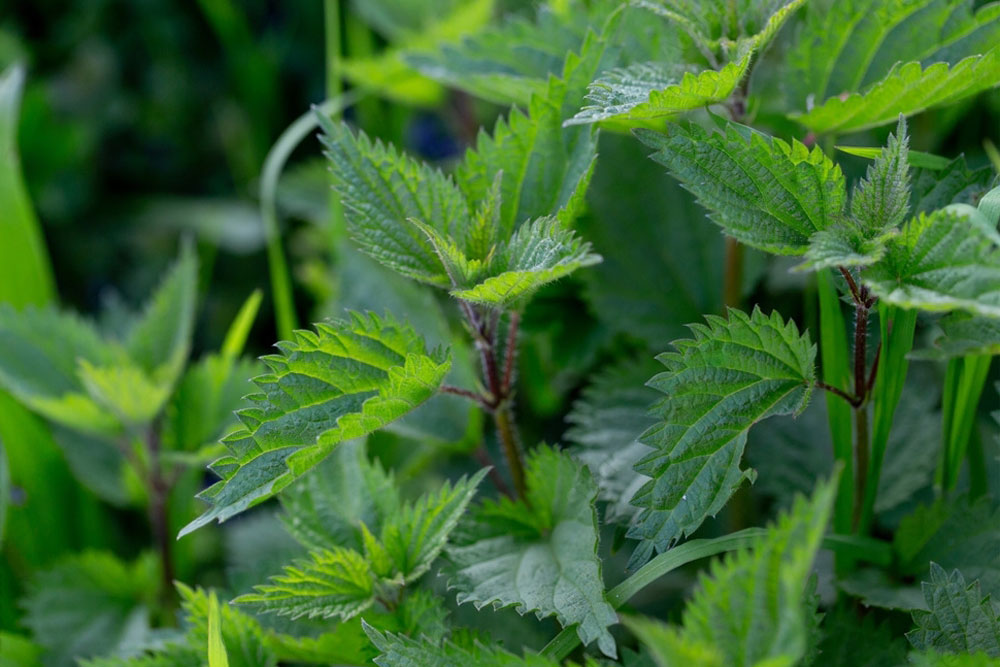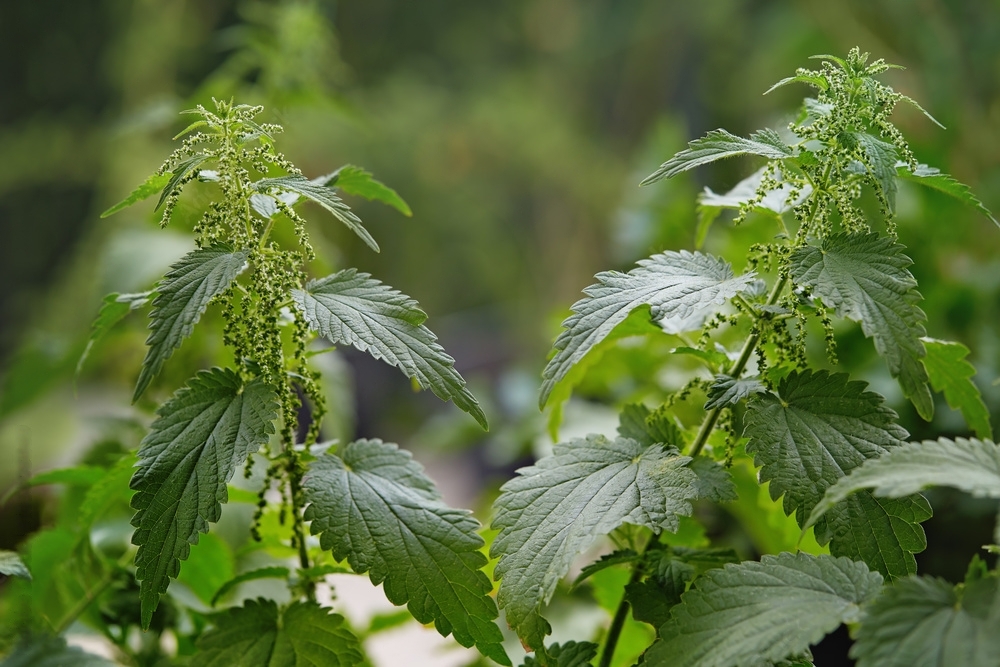The Culinary and Herbal Power of Nettles
As you wander through the verdant embrace of Marblehill in County Galway, Ireland, you might encounter a plant that evokes a childhood memory – the nettle (Urtica dioica), also known as stinging nettle, or the Irish Name (Neantóg). Renowned for their prickly sting, nettles might seem like an unwelcome surprise. But beneath their spiky exterior lies a treasure trove waiting to be discovered. Nettles offer a bounty for the adventurous forager, with a surprising culinary versatility and a rich history of herbal uses.
Beyond the Sting: A Forager’s Delight
Nettles, once a staple food in medieval Europe, is experiencing a resurgence in modern cuisine. Their young leaves boast a surprisingly mild, spinach-like flavour, making them a perfect addition to various dishes. Foraging for nettles allows you to connect with the land and add a unique, local touch to your meals. Here are some ideas to get you started:
- Nettle Soup: A hearty and nutritious soup made with foraged nettle leaves, potatoes, cream, and your favourite seasonings.
- Nettle Pesto: A delicious twist on a classic pesto, using nettles instead of basil for a vibrant green colour and a slightly earthy flavour.
- Nettle Sauté: Sautéed nettle leaves with garlic and olive oil make a delightful side dish or can be enjoyed as a filling for omelettes or frittatas.

Remember: Before consuming nettles, ensure they are young and tender. Wear gloves when foraging to avoid getting stung, and blanch the leaves to remove the stinging properties.
A Treasure Trove of Nutrients
Don’t be fooled by their humble appearance; nettles are packed with essential nutrients. Nettle leaves are rich in vitamins A and C, as well as iron, protein, and other minerals. This makes them a valuable addition to any diet, especially for those seeking a natural source of vitamins and minerals. Nettles are also surprisingly high in protein, containing all nine essential amino acids.
A Natural Remedy: Unveiling Nettle’s Herbal Power
Nettles have been used in herbal medicine for centuries. Here are some potential benefits:
- Anti-inflammatory and Allergy Relief: Nettle tea is a traditional remedy for soothing allergies and reducing inflammation. Studies suggest that nettle leaf extract may help reduce symptoms of seasonal allergies, including hay fever.
- Digestive Aid: Nettles are believed to aid digestion and may help alleviate symptoms like bloating and constipation. Nettles may also support gut health due to their prebiotic properties, which are fibres that nourish the good bacteria in your gut.
- Skin Health: A nettle tea infusion can be used topically to soothe irritation and promote healthy skin. Nettles may help with conditions like eczema and psoriasis, although more research is needed to confirm this benefit.
- Increased Red Blood Cell Count: Consuming nettles can also aid circulation by helping to increase our red blood cell count.
Important Note: Consult a healthcare professional before using nettles medicinally, especially if you are taking any medications.

Sustainable Foraging at Marblehill
Nettles are a readily available and renewable resource. Here are some tips for responsible foraging at Marblehill:
- The Time is Right: For the best flavour and texture, forage for nettles in the spring, ideally before they flower (usually around March to May in Ireland). As the plant matures, the leaves become tougher and develop a stronger sting.
- Respect the Patch: Only harvest a small portion of the plant and leave enough for it to regenerate. This ensures the continued availability of nettles for you and future foragers.
- Location Matters: Avoid foraging for nettles near busy roads or areas where they might be contaminated with pesticides. Look for healthy patches in clean, undisturbed areas.
- Know Your Nettles: Always ensure proper identification before consuming any wild plants. Look for reliable resources or consult a foraging expert to avoid accidentally harvesting a look-alike plant that may be harmful.
From Leaf to Seed: Unveiling the Full Potential of Nettles
Once you’ve mastered the art of safely harvesting young nettle leaves, don’t overlook the potential of nettle seeds. As the plant matures and flowers in the summer, it produces an abundance of tiny seeds packed with their unique benefits.

Nature’s Energy Boost: Nettle Seeds
Nettle seeds can be enjoyed fresh or dried. Fresh seeds offer a more intense, earthy flavour, while dried seeds retain a subtler taste but are still a great addition to your diet. No more than 20g of nettle seeds should be consumed in a day, and a teaspoon a day is a commonly recommended serving. Here’s how to incorporate them into your diet:
- Straight from the Jar: Once dried, nettle seeds can be enjoyed straight from the jar, offering a quick and easy nutrient boost. Sprinkle them over cereal, yoghurt, or salads for an added earthy crunch.
- Tea Time with a Twist: Nettle seeds can be brewed into tea for a gentle energy boost. Simply steep a teaspoon of seeds in hot water for 5-7 minutes, then strain and enjoy. You can add honey or lemon for extra flavour.
- Tincture Power: For a more concentrated dose of nettle seed benefits, consider making a tincture. This involves soaking the seeds in alcohol for several weeks to extract their medicinal properties. Consult a herbalist for guidance on the safe preparation and use of nettle seed tinctures.
A Few Culinary Ideas for Nettle Seeds:
While nettle leaves offer a delightful burst of green in your dishes, nettle seeds provide a unique textural and flavorful element to your culinary creations. Here are some ideas to inspire you:
- Baking with Benefits: Substitute a portion of poppy or sesame seeds in your favourite baking recipes with nettle seeds. This adds a subtle nutty flavour and a welcome boost of protein and fibre to muffins, cookies, and bread.
- Energy Bar Powerhouse: Homemade energy bars are a great way to incorporate nettle seeds into your diet. Mix them with nuts, dried fruit, and other nutritious ingredients for a delicious and healthy snack.
- Savoury Seed Sprinkle: Elevate your soups, stews, and roasted vegetables with a sprinkle of nettle seeds. Their earthy flavour complements a variety of savoury dishes, adding a touch of the wild to your meals.
Lookalike Warning: When foraging for nettles, it’s crucial to be aware of potential lookalikes. Dead nettles and yellow archangels can resemble nettles, but they are not harmful and don’t sting. Here’s a quick guide to help you distinguish them:
- Dead Nettles (Lamium purpureum): These have square stems and lack the characteristic stinging hairs of true nettles. Their flowers are often purple or pink, while true nettles have small greenish flowers. Dead nettles are edible and can be used similarly to true nettles.
- Yellow Archangel (Lamiastrum galeobdolon): These also have square stems and no stinging hairs. Their flowers are yellow, unlike the greenish flowers of true nettles. Yellow archangels are also edible.
Embrace the Stinging Nettle: A Rewarding Foraging Adventure
Nettles, once a common weed, is now recognized as a valuable addition to the forager’s repertoire. With a little caution during harvest and a dash of culinary creativity, you can unlock the hidden potential of this versatile plant. So, the next time you encounter a patch of nettles, don’t shy away – embrace the potential for a delicious and nutritious wild harvest! Remember, with proper knowledge and responsible foraging practices, nettles can transform from a stinging surprise to a rewarding discovery, enriching your meals and your connection to the natural world.






